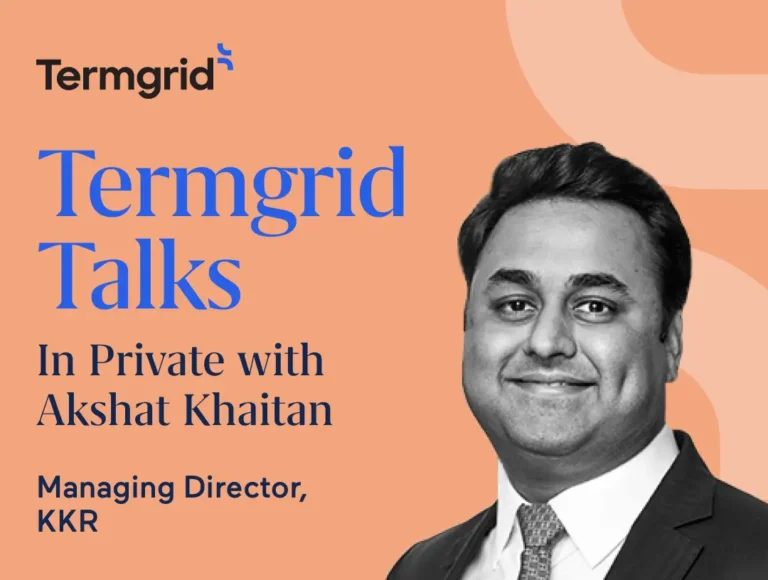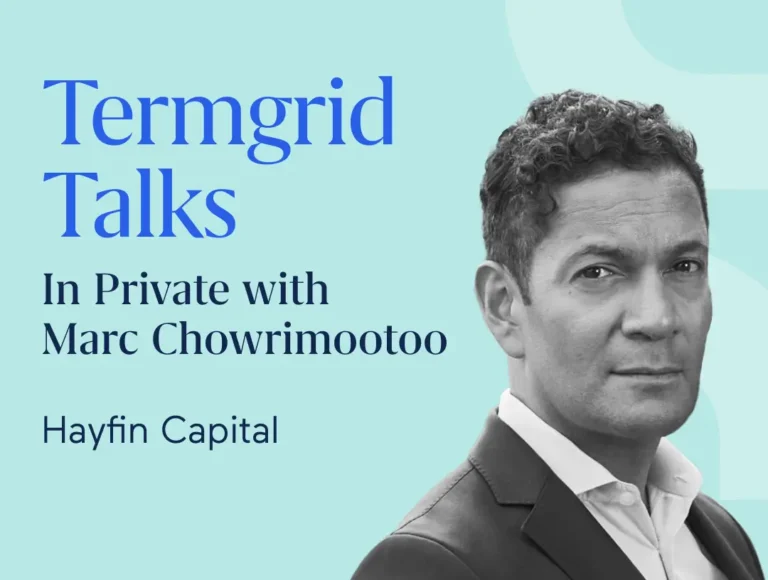In this episode of Termgrid Talks, Dipish Rai spoke with Tara Moore, Managing Director and Head of European Originations at Golub Capital.
Since its launch in early 2020, Golub has navigated a complex market landscape, from pandemic-era uncertainty to becoming a leading force in European private credit with over $9 billion in gross originations. Tara, who was employee number one in London, shares her first-hand experience of building the business from the ground up, the strategic choices that defined Golub’s European presence, and the lessons carried over from the firm’s long-standing U.S. success.
You can read the full transcript below or complete this form to have the complete report emailed to you as pdf.
Dipish Rai: Thank you for being part of Termgrid Talks.
Tara Moore: Pleasure.
Dipish Rai: Golub has been operating in Europe for five years now and completed that milestone. So congratulations on that.
You’ve been there from day one. Take us through that journey a little bit and some of the challenges and decisions that you made that shaped the success today.
Tara Moore: Yeah, of course. Thank you for having me, firstly. I’m very proud of what we’ve achieved in the last five years, as you can imagine.
If I cast my mind back, I started in February 2020 – and if we all remember what was going on in Q1 of 2020, it wasn’t the easiest start to any year. I remember being in the New York office, I had a slight cold from the flight over, there was a virus in Seattle at the time and it was, do we think this is going to be something bigger?
Lo and behold, four weeks later, we had the UK lockdown. And I was employee number one sitting in London for Golub, pretty much with a pot plant and a team’s connection. So definitely an interesting start.
But we’ve had a great run in the last five years. I’m very proud to say we’ve put about $9 billion in gross origination out the door in that period of time, across what is a relatively small team.
So some of the challenges. Obviously, that start wasn’t ideal. The world didn’t know which end was up, everyone was figuring out what the business world looked like, what their portfolios were going to do, whether there was going to be a liquidity crisis for these companies, how they were going to perform, etc.
So there was a little bit of a pause for our European expansion before we really got going in September 2020. So as we speak today, it really is our five year anniversary. In terms of the positives, Golub is a very well known brand in the US. And while it’s not perfectly transferable into Europe, it wasn’t our first European transaction when I landed over here. I was employee number one, but we had been working with a number of European sponsors that had gotten to know us in the US through portfolio companies. And then obviously, US sponsors that were starting to look into Europe a little bit more.
So we had done a handful of deals. So it was a good starting point. You know, we had to pick a spot. Some people knew who we were, other people mispronounced our name, which is always a good foot to get off on. But we explained who we are, what we do, how we think about the world.
And we were relatively conservative in how we started, we picked a spot. One of our USPs in the US is software lending. We decided that that was a great starting point for us here in Europe. So as a result, we’ve become quite well known as a key software lender. But that as we continue to grow is obviously growing in terms of our sector focus, our jurisdiction focus.
Dipish Rai: You touched a little bit on the U.S. The US has a storied history operating in the US market and operating through multiple market cycles.
You’ve talked about the USP. being software lending in the U.S. that you brought on here. From your vantage point leading the European business, what are some of the other best practices, lessons that have made the US successful, that you transported here in Europe and maybe you adapted them along the way to be successful here in this region?
Tara Moore: We have a 30-year track record in the US, 20 of which focused on senior lending to sponsors, and our objective is to be best in sponsor finance, whether that’s in the US or Europe.
Best practice? We do things ever so slightly differently, more, I guess, on a US model. So we split the origination and the underwriting function, because we believe that allows us to offer our sponsors the best relationship, depth of relationship with their lender, possible with that continuity of dialogue with key people within that team.
But then on the underwriting side, you know, we have scale there. We have more than 100 underwriters across the platform, both in the US and Europe. And that allows us to have a really deep knowledge of the sectors that we cover. So there’s very few sectors, sub-sectors, companies that we haven’t seen either directly or a comp to, whether it’s in the US or Europe. And that’s massively beneficial on a number of fronts.
One, we pride ourselves on our very low default rate and consistent invested returns over the years. But two, it’s that dialogue with the sponsor as well. They want to know – in very short timelines when we’re talking on processes – that we understand the companies that they’re interested in, and they’re not starting at ground zero to explain what it is that a healthcare IT software business is trying to deliver. So that best practice of being arranged across verticals within underwriting and having that deep dive across the portfolio, across the market has been very valuable.
Dipish Rai: So as the private credit market is becoming more and more competitive, especially in Europe where homegrown funds are rising up, you know, firms from the US are also coming in just like Golub. What do you think are the differentiating factors for you to succeed in this market from a sourcing perspective, from an underwriting perspective, and just general business growth?
Tara Moore: Sure, I think there’s probably a few legs to that stool. So let’s start on the sponsor angle.
As I mentioned, we split out origination from underwriting. So that origination piece, that relationship with the sponsor, what we’ve found over the years, both in the US and also here in Europe, sponsors want a smaller group of lenders that they can call and pretty much any opportunity they’re looking at, whether that is a 20 million EBITDA loan, a base loan or a recurring revenue loan right up to $75 million, $100 million and larger than that.
What we’ve found is a number of our competitors will focus on either end of that scale. We have a very broad church that we like to cover because we see the portfolio as something that we want to get into from an early point in time in their development and grow with that company.
So if you look across the sponsor base that we deal with, 90% of the sponsors are repeat for us. We try to be one of those key lenders that they call on for everything, be it big or small.
Then flipping over to what we will call incumbencies, i.e. the portfolio companies. We are happy to provide smaller loans on high growth companies because we know they’re going to be a consumer of capital.
We see the buy and build strategies that the sponsors are looking to. And through that dialogue from the sponsor side, understanding their strategy and also understanding the company where it sits in the market and its growth profile, marrying those two together gives you the best opportunity, I think, of ensuring you see all the opportunities within the market that you want to see. You follow on capital within your portfolio, which in a market as we’re in today with lower M&A is very valuable.
That on top of the underwriting prowess that I mentioned at the beginning, that depth of knowledge, that value add in the discussions with sponsors on companies that they’re looking at, we’ve found that to be very useful.
We will have a dialogue with a sponsor outside of an active deal that goes along the lines of, ‘tell us what you’ve looked at within the HCIT space’ or that health care software space that I referenced. What companies have you looked at? Why have you liked them? Which ones did you pass on? Why did you pass on them from a credit perspective?
So that sharing of information – obviously, within the realms of NDAs and necessary compliance – is very important value add to the relationship. So you’re not just a taker of transactions for the sponsor. You’re adding to the relationship and having that base of incumbencies of portfolio companies is very important to allow you to do that.
Dipish Rai: Talking about the current deal environment, give us your thoughts on the status of the market today, what’s the outlook for the remainder of 2025 / early 2026? How you see the market shaping up?
Tara Moore: I think the market has continued at a pretty low cadence in terms of new deals. From our perspective, when we came into 2025, the backdrop market chatter was that it was going to be a much bigger year for M&A. There was a view that there was a floodgate to open and M&A would increase. I don’t believe in floodgates. I believe in gradual increase in cadence.
When we hit January, it was very evident that that was not going to be the case. For a variety of reasons, we saw sponsors looking at opportunities and wanting to see the 2024 out turn before they pulled the trigger on any opportunity. So that naturally delayed everything into mid-February.
End of February, we saw a bit of an uptick in deal flow over the back end of Q1 going into Easter. But it has been patchy across the 2025 year. From our perspective, you could count on, maybe two hands how many interesting pure M&A opportunities there have been over the first six months of the year. We were busier again over the summer. But by and large, we’ve had a successful 2025. We’ve put a fair chunk of the budget out the door, to the point where Q4 will be to some degree upside for us. So we’re pretty pleased with where we stand.
But the portfolio has been the hero of the hour for 2025. I think across a lot of the market, we’ve seen some of our buy and build companies that we’ve lent to really consume capital this year as they do smaller tuck-ins, which are more achievable, I think, within this M&A environment.
2026? If you think about the timing and where we are, the 2021 assets are approaching four or five years old in 2026. At what stage do we genuinely see an increase in cadence, do these companies just bite the bullet and come to market? I think we will see some of that in 2026. But as I said earlier, I don’t believe in a floodgate.
Dipish Rai: So Tara, now looking ahead, what do the next five years for Golub look like in Europe?
Tara Moore: The next five years, as you can imagine, are front and centre. As we sit here today, we’ve talked about what we’ve achieved over the last five. But as we look forward, when we started, it was very much with a deliberate software focus. Jurisdictionally, we were looking at the UK, Germany, some of the Nordic countries. That needs to expand across the whole of Europe now.
And also, we’re expanding our sectors. So over the last 18, 24 months, we’ve started to do a little bit more within the insurance world. So we’ve done a number of the insurance brokerage deals within the market. We’ve done a number of financial services deals. So we like, you know, wealth managers, you know, we like fund admin. And we’re trying to play a little bit more into that space. We’re also trying to do a bit more within industrial and business services, which is a key vertical for us in the US, alongside healthcare, where we also focus on pharma services and medical devices. So as we look at the next five years, it is with a view of replicating what we have in the US in terms of breadth of sectors and approach.
Also, we have been growing in terms of scale and what we can do in terms of check size. So, you know, that’s moved up considerably over our time in Europe. And now we can come to the table with considerable checks.
But also, we start at the smaller end of the range to allow for that growth to come through. So I think it takes the depth of pocket question for the sponsor off the table when you are covering that broader church. And now that it’s covering broader sectors and jurisdictions, we can be called on pretty much any opportunity they think suits our investment focus.
Dipish Rai: You began your career in banking and transitioned into private credit when this industry was still pretty nascent. What drove you towards private credit and what advice would you have for somebody looking to get into private credit and make a similar move?
Tara Moore: When I was prepping for this and thinking about it, it’s the one [question] that probably caused me the most pause.
I look back over my career and I just see 25 years of leveraged finance and very little differentiation across the piece. It’s very much, how do I get the deal done? How do I have the relationship with the key sponsors in the market? And how do I put best of class assets in the portfolio? Whether I’m sitting in a bank or I’m sitting in a fund that has always been my approach.
But when I look back over it, why did I make the jump out of the bank into the fund? At that time it was very much a product within the mid-market space that was being de-emphasized by the banks. The banks had some caps on what they can hold in any given deal. It’s expensive for them to allocate capital against these transactions. And that was becoming more and more clear as we went through 2010 into 2012 and the market was starting to reopen and gain confidence again after the great crash.
So I figured actually the future of deal doing was going to be within the private markets. We had seen the boom starting, within private equity. It made a lot of sense for there to be a mirroring private credit angle. I felt like that was the spot that I would get to look at the best deals, the larger variety of deals, the best in class, without going into more a large cap syndicated, broadly syndicated team, like a JPM or a Goldman’s.
That’s never where I was in my career. I preferred the smaller mid-market space. It made a lot of sense for me at the time to move over and help develop that for one of the fund managers that was coming over from the U.S.
Dipish Rai: And what advice would you give to somebody who’s looking to get into this market now, all the growth that Private Credit has seen? How should they think about their career trajectory?
Tara Moore: When we interview for more junior colleagues, what are we looking for? We’re looking for curiosity.
You know, I think we’re looking for someone who has excellent technical skills. But that’s almost not secondary, it’s an assumption that they are there. We will test them naturally in the interview process.
But it’s that curiosity. Why do you want to look at a health care software business and then the next day, a pharma services business in Germany? What is it that interests you about the job? How do you see longevity within this career? And I think if if understanding businesses and what makes them work and how they grow and how they sit within the broader economic environment, if that’s of interest, then this is the job for you. You get to look at a lot of different companies.
Back in the day – I’’m dating myself now – but back in the day when site visits were more regular. It’s fascinating to see the inside of everything from a business that made curry for supermarkets where I had to wear pink wellies because the CEO thought it was very nice that he had a woman coming to the site. So he had pink wellingtons made for me to actually understanding how extractor fans work in massive engineering efforts for tunnels.
So it’s very broad, it’s very varied. And no two days are the same from a deal perspective. If your curiosity leads you down that road, this could be an interesting angle.
Stay in touch with all of our latest updates and articles. Sign up now.



